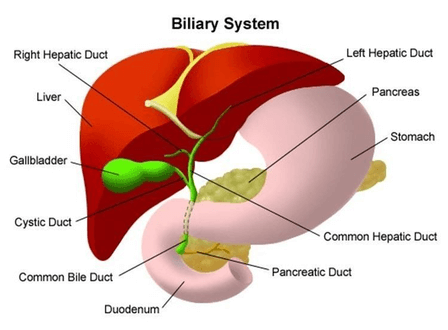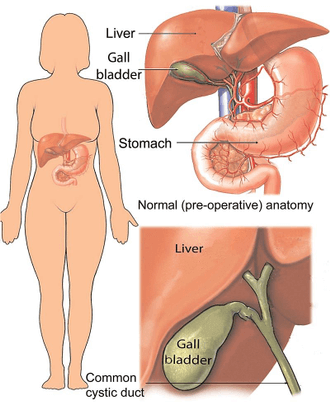Gallbladder Surgery
Removal of the gallbladder (cholecystectomy) is one of the most common operations perfomed by Dr McGregor.
In over 99.5 % of cases this is completed by laparascopic (keyhole) techniques.
What are gallstones and how do they form?
Gallstones are formed in the gallbladder and vary in size, shape and colour. Some stones contain a large amount of cholesterol and these stones tend to be yellowish in colour. Others are dark green or black in colour and these are pigment-type gall stones.
The liver manufactures bile which travels down the bile duct. Some of the bile is then directed into the gallbladder and concentrated. In susceptible people, the concentration of bile triggers the formation of crystals that slowly grow to form gallstones. This process usually occurs over a number of years, but can occasionally occur quite suddenly such as during rapid weight loss.
Who gets gallstones?
Gallstone prevalence increases with age and by the time we reach our later years, approximately 15% of the population will have developed gallstones. Females are more prone to developing gall stones than males. During pregnancy the function of the gallbladder is diminished and resulting bile stasis appears to make stone formation more likely. Excess weight is another factor that increases gallstone formation and this relates to increased cholesterol content in the bile. Gallstones sometimes run in families.
What are the usual symptoms of gallstones?
When you eat a meal, especially a fatty meal, a hormone is released which causes the gallbladder to contract and squeeze concentrated bile into the bowel. Bile is necessary for the digestion of fat which (when not in excess) is essential to health. Sometimes a stone jams in the outlet of the gallbladder and blocks the bile from getting out of the gallbladder. The gallbladder continues to contract against the stone and this is what causes the pain of a gallbladder attack. In many cases the gallstone will release spontaneously and symptoms disappear. Episodic attacks of pain ranging from mild to very severe are the most common symptoms of gallstones. The pain often occurs during the night or after a fatty meal. The pain is usually situated in the upper part of the abdomen and under the right ribs. The pain often radiates around and into the back on the right side. Occasionally the pain is felt in the lower chest and the symptoms can be confused with a heart attack. If the gall stone fails to release, the gallbladder may become acutely inflamed and this condition is known as acute cholecystitis. In some cases, this may lead to a serious infection with gangrene of the gallbladder. Other symptoms such as nausea, flatulence (belching) and intolerance of fatty foods are often attributed to gallstones but these can be caused by other conditions and may or may not improve after the gallbladder is removed.
How are gallstones diagnosed?
Ultrasound of the abdomen is the standard way of diagnosing gall stones. This is a painless examination that allows the stones within the gallbladder to be seen in the majority of cases. Blood tests to measure the function of the liver and the pancreas may also be used to determine the likelihood of stone migration from the gallbladder into the bile duct. More complicated tests including imaging of the main bile ducts may be necessary involving CT or MRI scans. Occasionally ERCP is necessary to diagnose and remove stones from the bile ducts.
I have gallstones but no symptoms!
Sometimes gallstones are diagnosed during tests for other conditions, but there have been no symptoms of gallbladder disease. In general we don’t recommend removal of the gallbladder in this situation, but each person and situation is different. If, for example, you had gallstones without symptoms and planned to spend a year in the Outback, Antarctica or travelling the world there may be a place for removing the gallbladder even though you have no symptoms. We recommend careful discussion with Dr McGregor before embarking on gallbladder removal in the absence of symptoms.
I have symptoms of gallstones but no gallstones!
It is recognised that a very few people can have gallstone type symptoms without gall stones being found. This condition is challenging for both patient and doctor and requires very careful consideration and multiple diagnostic tests before going ahead with surgery. In the absence of gallstones no guarantee can be given about relief of symptoms by surgery to remove the gallbladder.
What are the complications of gallstones?
Some people will endure repeated attacks of gallbladder pain over many years without any complications occurring. However, complications can and do occur and the following should be considered very carefully if you decide not to have surgery for your gallstones. The major complications of gallstones are:
Acute cholecystitis (inflammation of the gallbladder). The stone gets stuck in the outlet of the gallbladder and does not release. First there is a chemical reaction of the bile literally starting to digest the gallbladder causing inflammation and unremitting pain. Then the bacteria naturally occurring in the gallbladder get into the act and the resulting infection makes the situation worse and can lead to gangrene of the gallbladder. Emergency surgery is usually recommended and keyhole surgery may not be possible.
Jaundice (yellow discolouration of the skin and eyes). This occurs when a stone gets stuck in the main bile duct and blocks bile going from the liver to the bowel. There is a backup of bile into the liver which then cannot function properly. Bile is absorbed into the bloodstream and this stains the skin and other organs a yellow colour. Secondary infection of the bile ducts can occur (cholangitis) which can be life threatening. The stone(s) must be removed from the bile duct urgently by ERCP or surgery.
Pancreatitis. A stone in the main bile duct can interfere with the pancreas and cause pancreatitis. This is potentially a life threatening illness and requires hospital treatment by an experienced surgical team.
Cancer. Although rare, cancer of the gallbladder can occur and may be fatal. Cancers usually occur when gallstones have been present for 20 years or more.
What treatment is recommended for symptomatic gallstones?
Providing you have significant symptoms related to gallstones, in almost every case we will recommend keyhole (laparoscopic) surgery to remove the gallbladder. Exceptions are occasionally made for the elderly in whom the attacks are not frequent or severe or those with major illnesses which could make the operation more dangerous than the gallstones.
Can gallstones be treated without surgery?
No. There are no satisfactory means of treating gallstones other than surgery. Both ultrasound disintegration and chemical dissolving of gallstones with tablets have been tried. In only a very few patients is the treatment successful, but even in these cases the stones almost always recur within months or a year or two.
Why take out the gallbladder, why not just remove the stones?
Good question! Firstly, removing just the stones from the gallbladder is extremely difficult and much more dangerous than taking out the gall bladder. More importantly, even if you could just have the stones removed safely, they would almost certainly form again in the coming months or years and it would be back to square one!
How will I get on without a gallbladder?
Quite well actually! The function of the gallbladder is to concentrate and store bile. When you eat a meal, particularly a fatty meal, a large amount of concentrated bile is released into the duodenum. This enables a very large amount of fat to be digested at once. Eating large amounts of fats (which are very high in calories) was, in hunter/gatherer times, very important for survival. In the days of refrigerators and three meals a day this is no longer necessary and may be harmful. With the gallbladder removed, bile is released in small amounts continually into the duodenum. This is adequate for all normal eating situations. However if, after removal of the gallbladder, you were to eat a huge amount of fat at one sitting (which you should NOT do at any time), the fat may not be digested but will pass through the bowel and give you nasty diarrhoea.
The Operation to Remove the Gallbladder - Laparoscopic Cholecystectomy
Laparoscopic cholecystectomy is the medical term for removing the gallbladder using keyhole surgery. In Australia, laparoscopic cholecystectomy has been performed for over 30 years. Dr McGregor has extensive experience with this technique. The procedure is performed under a general anaesthetic (that means you are completely asleep!), with only 4 tiny (less than 1cm) abdominal incisions needed to complete the operation. A telescope with a camera and light source is inserted through one of the tiny incisions so that the gallbladder and surrounding structures can be visualised on a television monitor. The view obtained is very clear and actually magnified to allow precise dissection of the delicate structures surrounding the gallbladder. Special dissecting instruments are inserted through the other incisions to allow the gallbladder to be removed safely. The operation usually takes less than an hour.
What is a cholangiogram ?
A special x-ray is taken during your operation. This involves injecting x-ray dye into the bile ducts to ensure no stones have escaped from the gallbladder into the larger common bile duct (the main tube from the liver).
What happens if stones have escaped ?
Stones in the bile duct can often be removed from the cystic duct (gallbladder tube) using specialist techniques and equipment. Stones that are unable to be retrieved in this manner require removal with a special endoscopy procedure (ERCP) following initial recovery from surgery.
What is the effect of stones in the common bile duct ?
Stones in the common bile duct can either block drainage of bile, causing patients to become jaundiced (yellow) or block the drainage of the pancreas, causing pancreatitis. Although pancreatitis is usually mild, severe pancreatitis can have severe and life threatening consequences. Therefore it is important to remove all stones from the bile ducts.
Is gallbladder surgery safe ?
Gallbladder surgery is very safe. Significant complications are very rare. It is important to remember that all surgery carries risks, however, and complications usually relate to the degree of inflammation and disease associated with your gallbladder.


